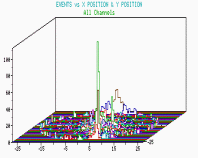TANKPAC
technology has been developed by PAC in
cooperation with oil industry. It is fast "sorting"
system that grades the tank floors their overall
condition, without emptying or cleaning the
tank.
Read
more about TANKPAC from NDT.net web page
The
test consists of attaching sensors to the outside of the tank and
monitoring for emission resulting from active corrosion of the floor.
Noise sources are eliminated by sophisticated pattern recognition
methods, and experienced operators.
Envirocoustics
engineers go through a rigorous training and certification program and
have to pass written and practical exams as well as meeting minimum
experience requirements. All work is conducted under an ISO-9002
documented procedure and a site report is given following the test.
 There
are many refineries where TANKPAC has
been used on virtually all the tanks, and the results are the key factor
in determining when they need to be removed from service for
maintenance. The procedure is a corporate recommended practice for many
companies. Although refineries and chemical plants are the major users,
the sensitivity of the method for locating active corrosion can be seen
by its ability to locate corroding zinc anodes in an oilfield production
tank.
There
are many refineries where TANKPAC has
been used on virtually all the tanks, and the results are the key factor
in determining when they need to be removed from service for
maintenance. The procedure is a corporate recommended practice for many
companies. Although refineries and chemical plants are the major users,
the sensitivity of the method for locating active corrosion can be seen
by its ability to locate corroding zinc anodes in an oilfield production
tank.
Correlation of the TANKPAC overall grade with actual follow-up internal
inspection shows the reliability of the method. In this case, the
inspection/repair result is rated as follows:
|
A |
No
damage, no repair |
|
B |
Minor
damage, no repair |
|
C |
Damage,
some repairs |
|
D |
Major
damage, many repairs |
|
E |
Sever
damage, many repairs, new floor |
Careful
review of all the TANKPAC information, and not just the "overall",
improves the reliability. The method is being continually refined and
improved as a result of the customer feedback. It is best suited to
tanks that are in the same service long-term. Additional monitoring may
be needed if the conditions in the tank are subject to changes as these
may start/stop the corrosion process.
Cost
savings depend upon tank condition. Saving the cleaning costs on 50% of
your crude tanks can amount to millions, and on very clean product
tanks, where many need no repair, savings can be huge when the overall
cost of shutdown, cleaning, and internal inspection are taken into
account.
ADVANTAGES
a)
Significant
money savings - No money wasted for opening of
good tanks.
b) Maintenance
prioritization - The most severely damaged tanks
are programmed for internal inspection first.
c) Ideal
tool for application of risk-based inspection
plans.
d) Prevention
of environmental losses - Early identification
of potential leaks.
e) Very
fast, low-cost inspection with minimal interruption
of operations and tank usage.


TANK
CARE:
A
complete above ground storage tank maintenance
and inspection program.